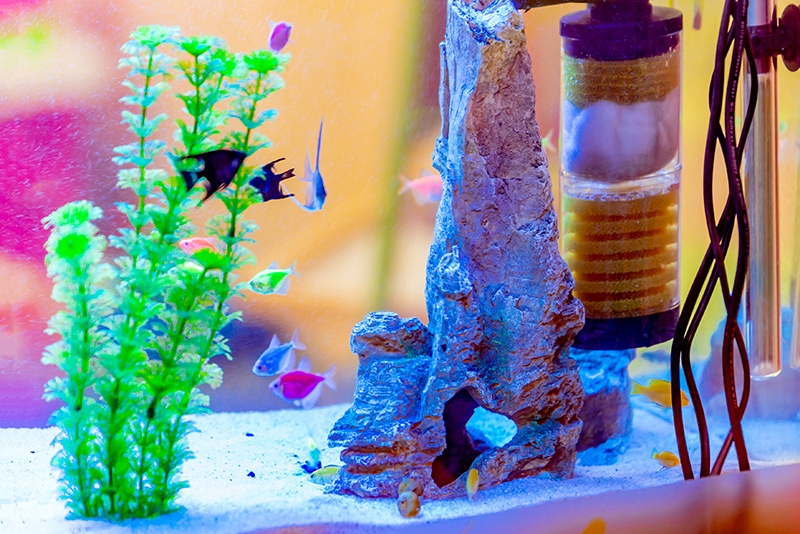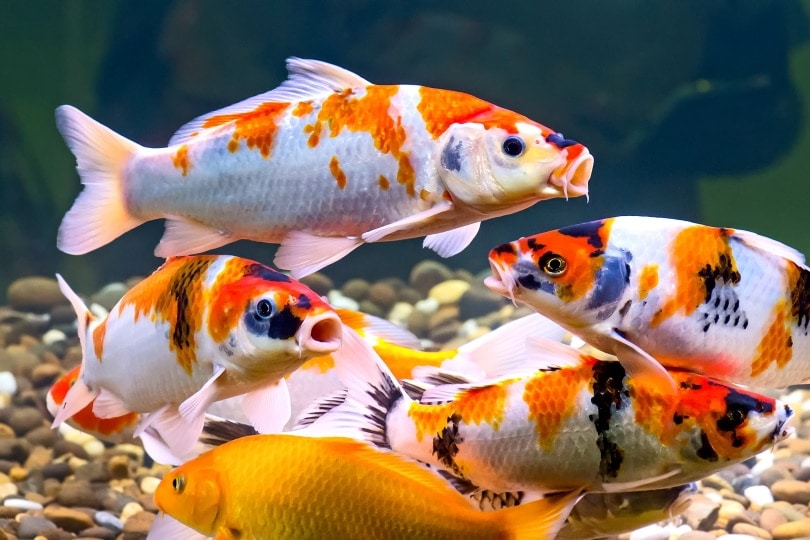Cardinal Tetra: Care Info, Types, Size & Lifespan (Vet-Reviewed Guide With Pictures)

Updated on
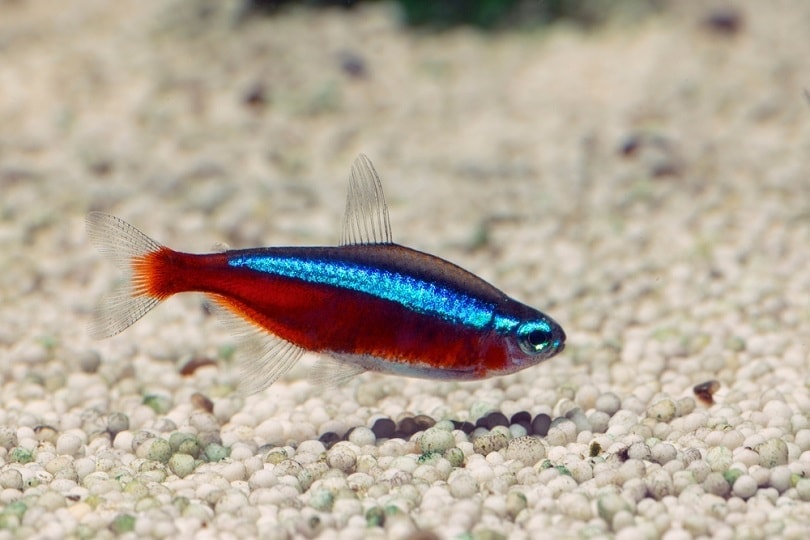
Cardinal tetras (Paracheirodon axelrodi) are brightly colored tropical schooling fish. They make perfect beginner fish and are hardy enough to survive a variety of tank conditions. Cardinal tetras swim in a synchronized school with interesting movements. The fish are becoming increasingly popular in the aquarium industry and are found in most pet stores. They do not grow too big and make great additions to planted small aquarium setups. This article will provide you with everything you need to keep healthy Cardinal tetras.

Quick Facts about Cardinal Tetras
| Species Name: | Paracheirodon axelrodi |
| Family: | Characidae |
| Care Level: | Easy |
| Temperature: | 24–30 °C (75–86 °F) |
| Temperament: | Peaceful in an appropriately sized school |
| Color Form: | Red and blue |
| Lifespan: | 2–5 years |
| Size: | 2 inches (5 cm) |
| Diet: | Predominantly predatory |
| Minimum Tank Size: | 20 gallons |
| Tank Set-Up: | Freshwater: heated, ideally planted |
| Compatibility: | Community friendly |
Cardinal Tetra Overview
Cardinal tetras are freshwater tropical fish from the family of Characidae. Cardinal tetras are gaining popularity for their beauty and availability. They are native to the Negro and Orinoco Rivers in South America. The South American continent is home to many Tetra species, and some are found in Africa or Central America.
Cardinal tetras are active and can be housed in a community tank in a variety of conditions. This makes them popular for novice aquarists. If Cardinal tetras are housed in appropriate conditions, they can live up to 5 years. They are easy to incorporate into tropical aquariums with over 20 gallons. These fish should be kept in groups of at least 8-10 as they are schooling fish.
They require a large yet sheltered open space to swim within. If they are kept in small groups under 5, they can become aggressive amongst each other and fin nip slow-moving fish that have flowing fins. Cardinal tetras are susceptible to developing illnesses from stress and an incorrect temperature that is either too low or fluctuates daily.
Ich, fungus, and bacterial infections are commonly seen in recently purchased tetras and those housed in poor conditions. An illness can rapidly wipe out an entire school of Cardinal tetras and wreak havoc within the tank. Care should be taken when creating their environment, and all requirements should be taken into consideration.

How Much Do Cardinal Tetras Cost?
Cardinal tetras are inexpensive; they are found in large chain pet stores and small locally owned fish stores. These fish can cost anywhere between $1 to $2 per fish. Due to their schooling nature, you must purchase a minimum of 8-10 Cardinal tetras to create a small school.
This can cost you between $10 to $25 for a group. This is relatively inexpensive and easy to accomplish, but Cardinal tetras are somewhat difficult to find online. They do not react well to the stress of shipping or fluctuating temperatures inside the shipping bag. If you order your Cardinal tetras online, you must choose the one-day shipping option. Although you will pay more for the shipping fees, it will be worth it when you are rewarded with healthy Cardinal tetras on arrival.
Typical Behavior & Temperament
These colorful shoaling fish enjoy being in large groups. In the wild, they will form groups consisting of up to 100 Cardinal tetras. They are content in captivity when they are kept in a group of 20 or more, but 8-10 can be used as a minimum guideline.
They swim together in the middle and lower part of the aquarium, which makes them good “centerpiece” aquarium fish. They can be semi-aggressive in small groups or under stressful conditions and will nip and chase other fish or other members of their school.
A group of Cardinal tetras is mesmerizing to watch as they swim through the aquarium. They are prone to being bullied by larger fish and even consumed. Cardinal tetras that witness their school members being killed or injured will experience high levels of stress and shy behavior.
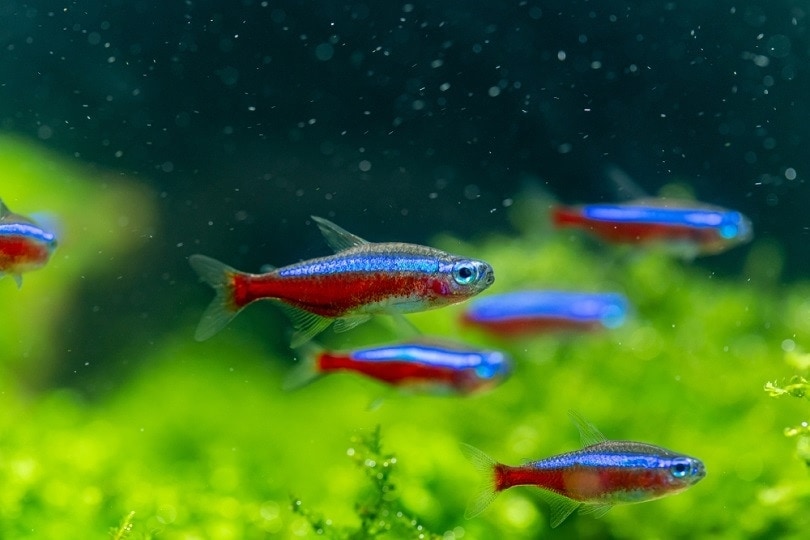
Appearance & Varieties
Cardinal tetras come in a standard red and blue form that resembles their neon tetra counterparts. This has given them the name Red neon tetras. The differences between the two are classified by Cardinal tetras being more colorful and having a vibrant red and blue coloration that does not glow as the standard neon tetra does. The red “stripe” of a Cardinal tetra runs the entire length of their body (which is not true for Neon tetras). In addition, they are also larger than Neon tetras.
Under the right conditions, the Cardinal tetra’s true coloration will shine. They are reflective under light and have a prominent green lateral line that enables them to identify their members within their school and stay in the group. They reach a maximum size of 2 inches but, like all fish, they don’t have an end-point of growth and continually grow throughout their life.
The females are rounder and have extended stomachs. The males have elongated bodies with flat stomachs. When the females are viewed from above, they have an oval shape. Their fins are small and are not easily identified from afar. Their color is their main attraction amongst aquarists and stands out vividly against a green-planted tank.
Cardinal tetras have a blue line along the bottom side, and a line separates the blue from the red that lines the bottom section. Although red and blue are their main colors, there are rarer colors available. Golds and silvers are seen in professionally bred Cardinal tetras and are not commonly seen in pet stores.

How to Take Care of Cardinal Tetras
Habitat, Tank Conditions & Setup
Tank/aquarium size: Cardinal tetras may be small, but they require a minimum tank size of 20 gallons. A smaller group of 10 can be housed in a tropical, freshwater tank of 20 to 30 gallons. If you keep them in small tanks, they become easily stressed and aggressive.
They make excellent nano tank fish and do well with tanks using the Halsted filtration method. The tank needs to have more length than height without decorations that divide the tank and potentially break up the school. Cardinal tetras do not belong in bowls, vases, or cups. It is a cruel practice to keep the fish in cramped spaces.
Water temperature & pH: Cardinal tetras are tropical fish, and it is essential to have a heater inside of the tank. They enjoy a temperature between 24–30°C (75–86°F). In these temperatures, they thrive and are most active. Efforts should be taken to ensure the temperature does not frequently fluctuate and cause illness and stress for your tetras. They require a pH between 5.5 to 7.5 and prefer slightly acidic water conditions.
Substrate: Cardinal tetras do not spend their time at the bottom of the tank. This makes it easy to choose a substrate for them. Gravel, aquarium sand, and pebbles work well. The substrate provides a place for beneficial bacteria to thrive and grow.
Plants: Cardinal tetras are naturally shy and enjoy living in a tank that is heavily planted.
Lighting:Cardinal tetras are native to dark waters. They may get stressed from a brightly lit tank – however this isn’t definitely proven and is likely speculation. Nonetheless, artificial lights that do not have the dim option should be avoided. Place the tank away from a window. If your tetra is in too bright of an area, you may notice them hiding away. You will find them under plants or inside decorations.
Filtration: These fish require a filter that produces a mild current. This will encourage your Cardinal tetra to swim against the current in the formation of their school. The filter should be able to filter 5 times the water volume in a minute and not have small openings your fish can get stuck in.
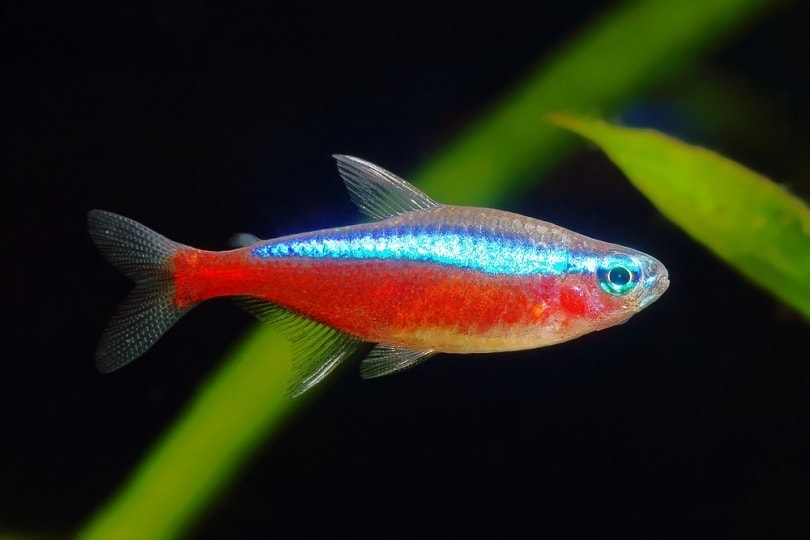
Are Cardinal Tetras Good Tank Mates?
Cardinal tetras are excellent peaceful community fish and can be housed with other small and peaceful community fish. They may nip the fins of fish like guppies or the Siamese fighting fish. They get along with several community fish. They should, however, not be housed with large fish like cichlids. If a Cardinal tetra can fit into a larger fish’s mouth, it will be able to consume your tetras in a matter of days.
Ensuring you keep these fish with appropriate tankmates is important. The tank should be large enough to house tankmates with Cardinal tetras. A minimum of 40 gallons is recommended for a school of Cardinal tetras and other peaceful, tropical fish. Cardinal tetras will usually ignore other tankmates and stick to following around their school. Territorial species of fish will bully and harass them to the point of injury or death.
- Neon tetras
- Zebra danios
- Bristlenose plecos
- Panda cory catfish
- Dwarf gourami
- Harlequin rasboras
- Mollies
- Yoyo loaches
- Zebra loaches
- Mystery snails
- Cherry shrimp
- Angelfish
- Cichlids
- Guppies
- Betta fish
- Rainbow shark
- Bala shark
- Iridescent shark
- Red-tailed sharks
- Oscars

What to Feed Your Cardinal Tetras
Cardinal tetras are primarily carnivores but will happily eat an omnivorous diet. They will eat live food, processed food, and anything placed in their tank. There are various foods to feed your Cardinal tetra. Each meal should be able to satisfy its species-appropriate guaranteed analysis. A varied diet consisting of protein-based foods and treats will ensure your tetra is receiving a balanced and optimal diet.
Protein-rich foods will bring out their true colors and make them glow, and dried commercial foods are easy to acquire for them. Foods such as sinking flakes, pellets, or granules work well. Commercial foods will have to be supplemented with live foods like daphnia, brine shrimp, tubifex worms, blood worms, or detritus worms. Mosquito larvae can be raised easily at home and provide a constant source of protein for your tetra.
Avoid foods that are marketed towards goldfish and cichlids. They lack the overall guaranteed analysis your Cardinal tetra requires to stay healthy. Both live and frozen foods are rich in nutrients that your Cardinal tetra requires to develop, grow, and reproduce. Take care not to overfeed them, as they will continue to eat until they develop bloat.
Keeping Your Cardinal Tetras Healthy
- A large aquarium: Providing your Cardinal tetra with a large swimming space will minimize the stress brought on by cramped conditions.
- Quality diet: Purchasing quality branded foods is the best way to ensure quality nutrition. They will live longer on a diet that is rich in nutrients and minerals. A Cardinal tetra that is fed an incomplete diet will suffer from stunting and deformities. Their lifespan will also be drastically shortened.
- Compatible Tank Mates: To keep the peace amongst the inhabitants, choose fish from our suitable tankmates list above. If all the inhabitants get along and do their own thing, the fish will remain happy and healthy. Stress takes a major toll on their bodies and weakens their immune system.
- Ideal water conditions: Ensure your Cardinal tetra’s temperature and pH range is met. Keep it stable and within the recommended range. Make sure you add dechlorinate into the water to avoid chlorine burns and eventually death.
- Treatment when ill: If one of your Cardinal tetras develops an illness, you need to immediately treat and isolate the fish. An illness can rapidly spread in the school and cause fatal deaths. Treatment should be suitable and target the specific illness.
Breeding
Cardinal tetras naturally breed in shaded areas provided by plants upstream within the aquarium. They can be successfully bred in captivity, but you should replicate their natural environment to encourage breeding. Dimming the aquarium lights is the first step. Ensure the filter is on and you do renewal water changes frequently.
The temperature should be increased slightly, and all pollutants should be removed from the water by a gravel vacuum. Ensure both the female and male fish are getting high amounts of protein before you decide to breed them. This ensures quality offspring.
The mating ritual involves the male Cardinal tetra swimming alongside the male. The female will deposit her eggs, and the male will fertilize them. Once the eggs hatch after a maximum of 3 to 4 days, you should feed the small fry infusoria or commercial foods specially formulated for small fry that cannot eat an adult diet. Keep in mind that the adults will indiscriminately eat their eggs and young and therefore, they should be separated from the eggs after spawning.

Are Cardinal Tetra Suitable For Your Aquarium?
If you enjoy the vivid colors that the Cardinal tetra provides, they may be the right schooling fish for you. Keeping a large, planted tank with a heater and filter is recommended. The tank should contain compatible tank mates and should be elongated to provide enough midwater swimming ground. If you can meet the Cardinal tetra’s needs, they will thrive in your aquarium.
Ensure the tank can house 8-10 or more adult tetras because they are known to grow relatively fast. We hope this article enlightened you on the species-appropriate care that Cardinal tetras require.
Featured Image Credit: InsectWorld, Shutterstock

